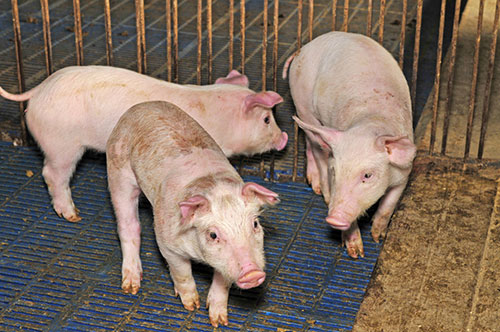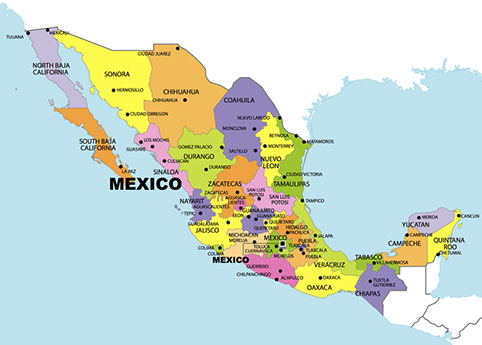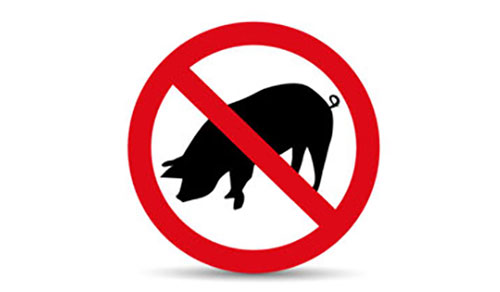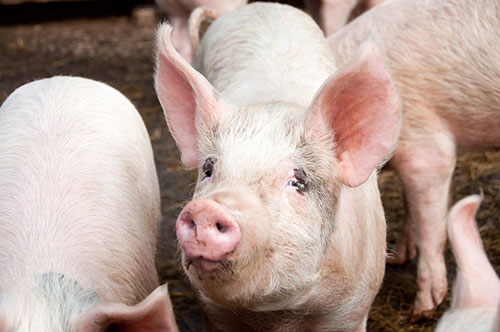



PRRS in Latin America
Research from Mexico, Chile, and Colombia indicates that PRRS remains an important swine health challenge in Latin America. This research was presented in various poster sessions at the 24th International Pig Veterinary Society Congress, Dublin, Ireland, June 2016.
Histopathological and molecular findings in emaciated pigs from Mexico
J. Segalés from Barcelona and his colleagues from universities in Spain and Mexico identified microscopic lesions and involvement of a number of viruses in emaciated piglets.
Wasting of post-weaning piglets is a problem of global pig farming. The most important viral diseases linked to this problem in Mexico are porcine circovirus type 2 (PCV2)-systemic disease, porcine reproductive and respiratory syndrome (PRRS) and blue eye disease (porcine rubulavirus - PoRV); the latter, is only present in Mexico. These diseases cause great economic losses and predispose the pigs to the development of co-infections, mainly with bacteria.
Thirty-seven necropsies of pigs with poor body condition were performed in the Bajío region of Mexico. Inclusion criteria were 6-16 week-old pigs displaying marked growth retardation (body condition scoring 1 or 2).
Histopathologically, interstitial pneumonia was observed in 25/37 (68%) of the piglets, catarrhal-purulent bronchopneumonia was observed in 7/37 pigs, broncho-interstitial pneumonia was found in 5/37 pigs and 2/37 animals had fibrino-hemorrhagic-necrotizing pleuropneumonia. Also, a varying degree of lymphocyte depletion in lymphoid organs was found in 14/37 (38%) animals.
A total of 16/37 (43%) pigs were PCV2 PCR positive, 18/37 (49%) yielded a positive RT-PCR for PRRSv (North American strain) and 1/37 (3%) pigs positive for PoRV.
PCV2 and PRRSv co-infection was noticed in 7/37 (19%) piglets, while only 1/37 (3%) was positive both for PRRSv and PoRV. Finally, 10/37 (27%) animals were negative for all three viruses.
The research showed that 73% of wasted pigs were associated with infections or co-infections with PRRSv and PCV2.
It is important to highlight that 38% of pigs had pulmonary lesions suggestive of bacterial infections. It is possible that potential immunosuppression or immunomodulation of viral origin (PCV2 and/or PRRSv mainly) favored the development of these infections.
Results demonstrate that PCV2 and PRRSv are present very often (alone or in co-infection) in wasted pigs from Mexican farms. The PoRV played a relatively minimal role in the causation of emaciation in the studied pigs.

Epidemiological surveillance of PRRS in pig farms from Yucatán, Mexico
In the first of two studies by A. Alzina López and colleagues at the Autonomous University of Yucatan, Mexico, the researchers determined the PRRS status of replacement gilts and boars.
The state of Yucatan in southeastern Mexico is one the primary pig production areas in the country.
The acquisition of replacement gilts represents the main risk for the introduction of the disease to negative farms, or in this case, for the introduction of new virus variants to positive farms. The possibility of boars transmitting PRRS is important even when the animal does not show signs of the disease after infection.
The objective of the study was to determine the health status of replacement gilts and boars used for natural mating or semen donors regarding the virus of PRRS in farms using different control/prevention measures for the disease.
Blood samples were obtained in order to extract serum from animals of 23 farms that produce their own gilt replacements. Another 25 farms which use natural mating were also sampled. It is important to stress that in Yucatan there is no registry of PRRS samplings as in other parts of Mexico.
Results
- 8 out of 25 (32%) farms with boars resulted positive to PRRS virus by serology.
- 36 sera out of 128 (28.13%) from boars, were positive in the ELISA X3.
- 15 out of 23 (65.22%) farms using self-replacement gilts were positive to PRRS virus.
- 625 sera out of 1414 (44.21%) obtained from replacements gilts were positive to the ELISA X3.
- 4 quarantine areas with 155 animals were tested with no positive ELISA X3 results.
- All samples from boars (36) positive in the ELISA X3 were negative in the PCR.
- 6 out of 635 ELISA X3 positive samples from replacement gilts were positive in the PCR, belonging to two farms.
The ELISA X3 results indicate that both replacement gilts and boars have been exposed to PRRS virus (time of exposure was not determined). With respect to the PCR test, only two farms are certain to have the PRRS virus, because sera are not the best sample to detect the virus due to the short viremia.
It is possible to conclude that at least two of the sampled farms have PRRS virus circulation. It is suggested that prevalence of PRRS is low. It is recommended to sequence the PCR amplifications to determine the virus strain present in the positive farms, so specific control measures like vaccination can be implemented.
Dynamic of PRRS virus in farms with different strategies of control, in Yucatan Mexico
In a second study by the same team of researchers from the Autonomous University of Yucatan, the objective was to understand what happens to the PRRS virus on farms that are employing different strategies to control the diseases.
As in most pig production regions in the world, many farms in Mexico are positive to PRRS virus; however in the Southeast region there is little clinical evidence of the disease.
Ten farms with serological history were used, four were considered negative and six positive. In three of the positive farms, the disease control involves employing MLV vaccine. The fourth farm produces its own replacement gilts, checks for 100% seropositive (SP> 0.4) before introduction to the herd. The last two farms do not have any control strategies.
In negative farms, two showed 100% negative samples and two positive. Five farms had results with ELISA X3, that were inconsistent with their initial status. Four farms had negatives: two were 100% negative to RT-PCR and two positives. The fifth farm with positive initial status resulted 100% negative to ELISA X3.
The farms with positive initial status presented at least one sample positive to ELISA. With PCR, three farms showed at least one sample positive and three were 100% negative. The farms with negative initial status showed at least one positive sample to both tests.
Based on the results, two farms have a different status despite having no clinical signs consistent with PRRS. It was confirmed that oral fluids samples are a good alternative for surveillance studies in fattening pigs. PCR results suggest that the circulation of the PRRS virus in most farms in Yucatan is low.

Analysis of the recent re-introduction of PRRSv in Chile
V. M. Neira Ramirez from the University of Chile and colleagues from Chile and Minnesota, USA observed that PRRSv type 2 was first detected in Chile in 1999, the country self-declared PRRSv negative in February of 2013, but in October 2013, PRRSv was detected again. Their study summarizes the progress of the PRRS epidemic as they conducted a phylogenetic study to understand the origins and transmission of PRRSv within the country.
The first case was reported in a sow farm located in an area of high pig density. Clinical disease was severe and production was greatly affected. This event was followed by several outbreaks, where most of the national pig production is located.
The data from the PRRS national eradication program, launched in 2014, was used to describe the epidemic. A total of 26 sequences obtained between October 2013 and April 2015 were analyzed.
By the end of 2014, out of the 2,368 known pig sites (backyard and commercial) in the country, 98 had been diagnosed with PRRSv infection. Forty-three of these belonged to commercial pig sites and 55 to backyard pigs.
Viral sequences were closely related with 2012 and 2013 North American viruses, and very distant (~85% identity) to previous Chilean PRRSv.
Our analysis suggest that Chilean 2013-2015 PRRS viruses had a common ancestor in May 2012 and shared a common ancestor with the closest related sequence (PRRSV2/Indiana/XW079/2013) in April 2011.
The results show that viruses that affected Chile in 2013 were different from previous PRRS viruses, indicating a new viral introduction. Additionally, time to common ancestor of Chilean viruses suggests that these viruses may have evolved in Chilean pigs at least couple months before being detected in the first commercial farm.

Genetic diversity of PRRSv Colombian strains isolated between 1998 and 2014
J. D. Mogollon Galvis and colleagues from the National University of Colombia and the Colombian Agricultural Institute (ICA) conducted a phylogenetic analysis of ORF5 sequences obtained from different Colombian pig production regions between 1998 and 2014.
PRRSv has been recognized in Colombia since 1996. PRRSv shows a high degree of genetic variation and some antigenic heterogeneity. ORF5, the gene encoding the major envelope glycoprotein is the standard sequencing target and it is a valuable tool to understand what is happening in the field.
Samples were collected from different infected swine farms located in seven Colombian departments where pig production is well developed. The obtained ORF5 sequences were compared using 534 nucleotides from this gene. A dendogram was constructed using 55 strains and 71 reference sequences published in the gene bank which represented families from both genotypes.
All the Colombian isolates analyzed were included within the genotype 2 and were closely related to linage 5 strains where the prototype VR2332 is found. The Colombian genotype 2 sequences revealed a nucleotide similarity of ORF5 among the isolates ranged from 91.2% to 99.8% and had a 57% to 60% of nucleotide similarities with Lelystad strain.
These 55 Colombian isolates also shared a high nucleotide homology with the MLV Resp PRRS vaccine strain which was used in the country about 15 years ago.
Some Colombian farms are affected by genotype II PRRSV and its spread seems to be very low. Important nucleotide variations were detected within ORF5 antigenic epitopes in some isolates collected from the same farm or the same geographic regions.
This study also demonstrated that a low genetic variability exists among the circulating strains, which may be explained by the low selective pressure because the MLV was only used until 2004. It is concluded that circulating field strains may be vaccine virus derived strains.
July 2016
Photos: Shutterstock








